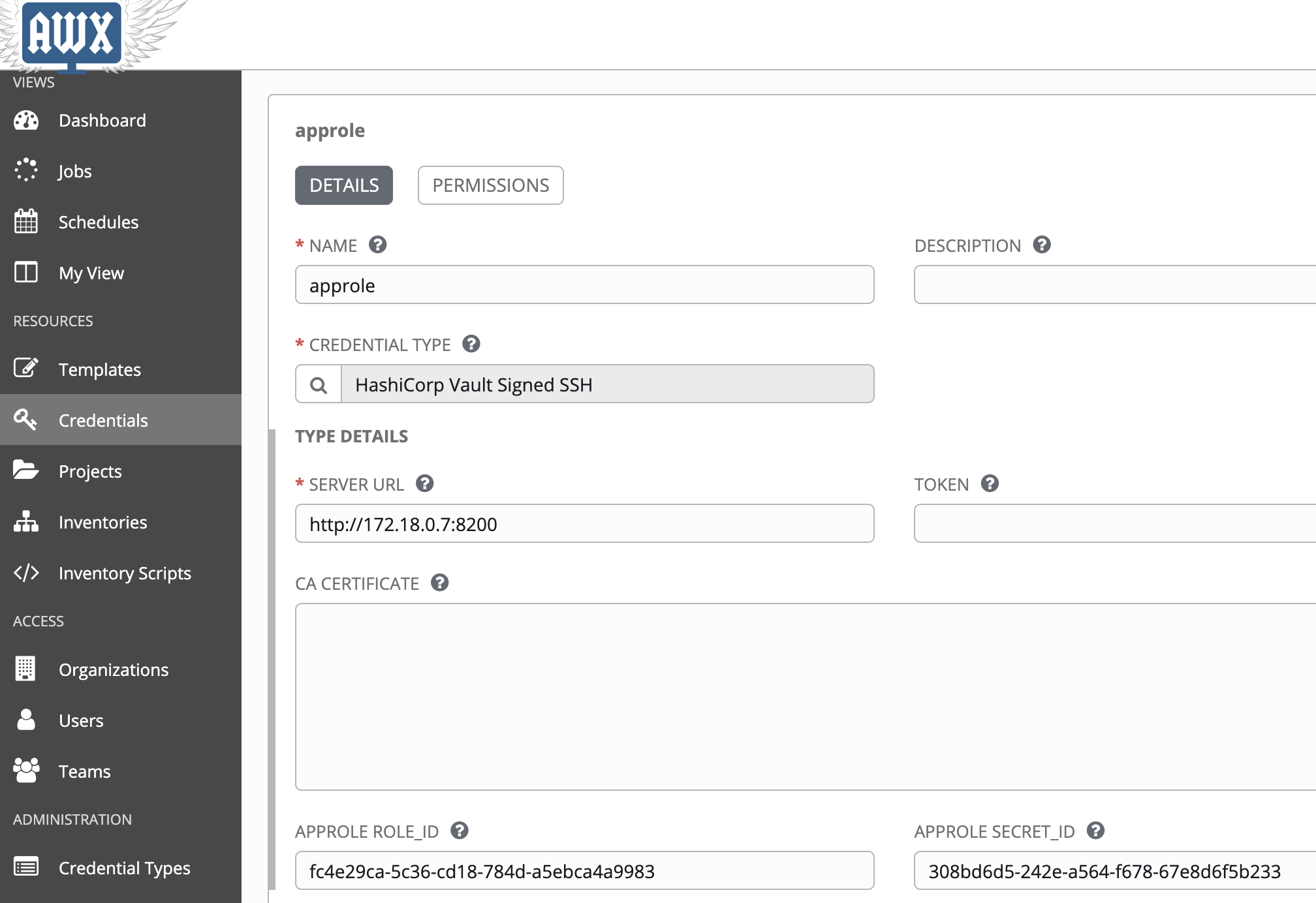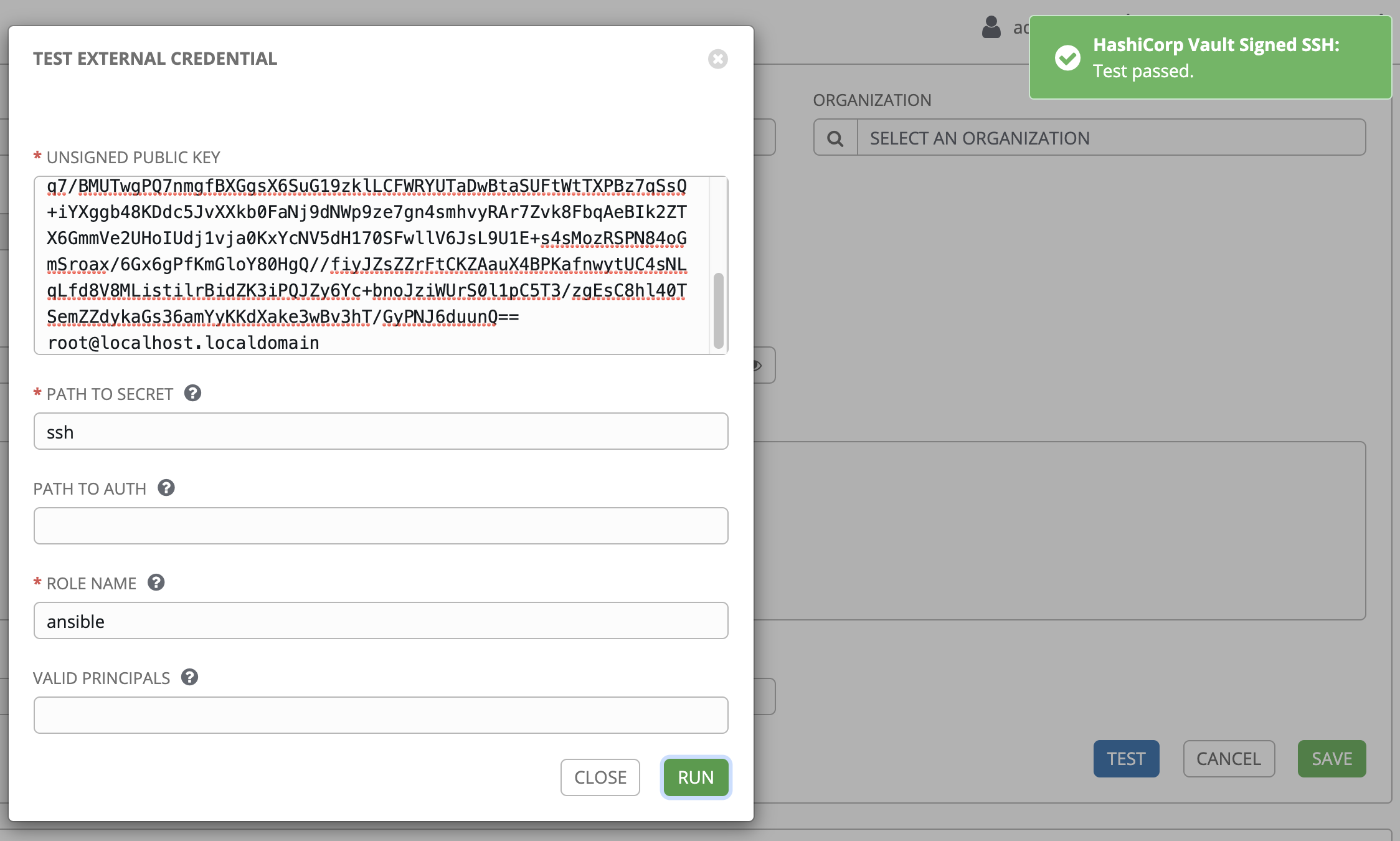Testing Ansible AWX with HashiCorp Vault AppRole authentication
This repo provides steps for testing a modified version of HashiCorp Vault credentials plugin: hashivault.py to support Vault AppRole Authentication method.
Please see the testing steps below:
- Pre-requisite: Approle Vault setup
- Testing on an existing Docker install
- Testing AppRole on new install on CentOS 8 using Vagrant
- Testing AppRole on new install on CentOS 8 on AWS (Coming soon)
Pre-requisite: AppRole Vault setup
To setup the AppRole Authentication method in Vault, we assume you have the vault binary on your path already. Please export an admin Vault token and Vault API address as below:
export VAULT_ADDR="https://<vault-dns>"
export VAULT_TOKEN="<root-or-admin-token>"
cd assets/
chmod +x setup-vault.sh
./setup-vault.sh
Testing on an existing Docker install
To test the modified version of Vault credentials plugin on an existing Docker based AWX deployment, you can inject the updated hashivault.py file in a new running container, or build a new awx_web image using the provided Dockerfile. Both methods are outlined below.
Method 1. Copying hashivault.py into awx_web container
# Run from the root of awx/ repo, stop the awx_web container:
docker rm -f awx_web
docker rm -f awx_task
cd awx/installer
/usr/local/bin/ansible-playbook -i inventory install.yml
# Run from the root of this repo:
docker cp assets/hashivault.py.v1 awx_task:/var/lib/awx/venv/awx/lib/python3.6/site-packages/awx/main/credential_plugins/hashivault.py
docker cp assets/hashivault.py.v1 awx_web:/var/lib/awx/venv/awx/lib/python3.6/site-packages/awx/main/credential_plugins/hashivault.py
Method 2. Building a Dockerfile
The steps below outline building a new awx_web image with the provided Dockerfile.
Note: Please substitute the version 9.2.0 with the version you want.
# Run from the root of this repo:
cd assets
sudo docker build -t ansible/awx_web:9.2.0 .
# Run from the root of awx/ repo, stop the awx_web container:
sudo docker rm -f awx_web
cd awx/installer
/usr/local/bin/ansible-playbook -i inventory install.yml
Please continue with the Test AppRole Authentication section
Testing on Vagrant CentOS 8 Ansible AWX install
These steps can be used to provision a CentOS 8 Vagrant VM and install the Ansible AWX application using Docker. A Docker vault dev server is also provisioned for testing AppRole Authentication.
Before running vagrant up, any customizations should be made to the inventory file such as admin passwords etc. Choosing non-default passwords are recommended.
Runing Vagrant
To provision, please run the command below:
vagrant up
**Note: You may get the following error, please re-reun vagrant up and it will continue to provision the machine
The following SSH command responded with a non-zero exit status.
Vagrant assumes that this means the command failed!
Access AWX
After the setup scripts finish, you should be able to access AWX web console at: http://localhost:9080. Please access it from a private browser session as there might be cached parts of the AWX external credentials UI. The default password is admin/password.
Test AppRole Authentication
Screenshots are shown below, more steps coming soon.
- From the Dashboard, click "Credentials" > "+" > Search
- Search for hashicorp and choose Credential Type "HashiCorp Vault Signed SSH"
- Put Vault address and a Role ID and Secret ID. These were saved in the
/home/vagrant/assetsdirectory in theroleid.jsonandsecretid.jsonfile.
**Vault Audit entries To review corresponding Vault audit entries, please use the commands below:
sudo docker exec -it vault "/bin/sh"
tail -f /tmp/vault_audit.log
# Perform some AppRole logins now to view Auth requests
** Example Audit entries:
- Approle login request and response with correct policies being mapped:
{"time":"2020-03-06T03:24:31.062003966Z","type":"request","auth":{"token_type":"default"},"request":{"id":"977a96c1-095c-2c5a-6637-5dc584b823f1","operation":"update","namespace":{"id":"root"},"path":"auth/approle/login","data":{"role_id":"hmac-sha256:f5037a656c39088abd6d3f0b2e74534b5543ad5c02dbb2da24e99dc6b63a05e3","secret_id":"hmac-sha256:1c29e88bbe7af4efe38e304017c402e6a210fcfd8c10d81e82f6fc08555c171c"},"remote_address":"172.18.0.5"}}
{"time":"2020-03-06T03:24:31.062818429Z","type":"response","auth":{"client_token":"hmac-sha256:e1afe3de4a437d3f1847779b6428f7ad07d01f19c8f6795ff0aeb0a02c834d03","accessor":"hmac-sha256:99174d26d1c642d81b72d29b57b43bab40e02e2122ecd04acca57c093545482e","display_name":"approle","policies":["ansible-ssh","default"],"token_policies":["ansible-ssh","default"],"metadata":{"role_name":"ansible"},"entity_id":"a4db4ab3-7605-f51c-cf0c-344245782f98","token_type":"service"},"request":{"id":"977a96c1-095c-2c5a-6637-5dc584b823f1","operation":"update","namespace":{"id":"root"},"path":"auth/approle/login","data":{"role_id":"hmac-sha256:f5037a656c39088abd6d3f0b2e74534b5543ad5c02dbb2da24e99dc6b63a05e3","secret_id":"hmac-sha256:1c29e88bbe7af4efe38e304017c402e6a210fcfd8c10d81e82f6fc08555c171c"},"remote_address":"172.18.0.5"},"response":{"auth":{"client_token":"hmac-sha256:e1afe3de4a437d3f1847779b6428f7ad07d01f19c8f6795ff0aeb0a02c834d03","accessor":"hmac-sha256:99174d26d1c642d81b72d29b57b43bab40e02e2122ecd04acca57c093545482e","display_name":"approle","policies":["ansible-ssh","default"],"token_policies":["ansible-ssh","default"],"metadata":{"role_name":"ansible"},"num_uses":100,"entity_id":"a4db4ab3-7605-f51c-cf0c-344245782f98","token_type":"service"}}}
- Certificate signing request with AppRole token:
{"time":"2020-03-06T03:24:31.06743862Z","type":"request","auth":{"client_token":"hmac-sha256:e1afe3de4a437d3f1847779b6428f7ad07d01f19c8f6795ff0aeb0a02c834d03","accessor":"hmac-sha256:99174d26d1c642d81b72d29b57b43bab40e02e2122ecd04acca57c093545482e","display_name":"approle","policies":["ansible-ssh","default"],"token_policies":["ansible-ssh","default"],"metadata":{"role_name":"ansible"},"remaining_uses":100,"entity_id":"a4db4ab3-7605-f51c-cf0c-344245782f98","token_type":"service"},"request":{"id":"40251df9-54fb-b3dd-8301-e3bdc80e685e","operation":"update","client_token":"hmac-sha256:e1afe3de4a437d3f1847779b6428f7ad07d01f19c8f6795ff0aeb0a02c834d03","client_token_accessor":"hmac-sha256:99174d26d1c642d81b72d29b57b43bab40e02e2122ecd04acca57c093545482e","namespace":{"id":"root"},"path":"ssh/sign/ansible","data":{"public_key":"hmac-sha256:690abcb0efafe6b2c07bc9493393e819b7841b5eff6d491fd7ea9eabef86e281"},"remote_address":"172.18.0.5"}}
Destroy
To destroy, run the command vagrant destroy.

